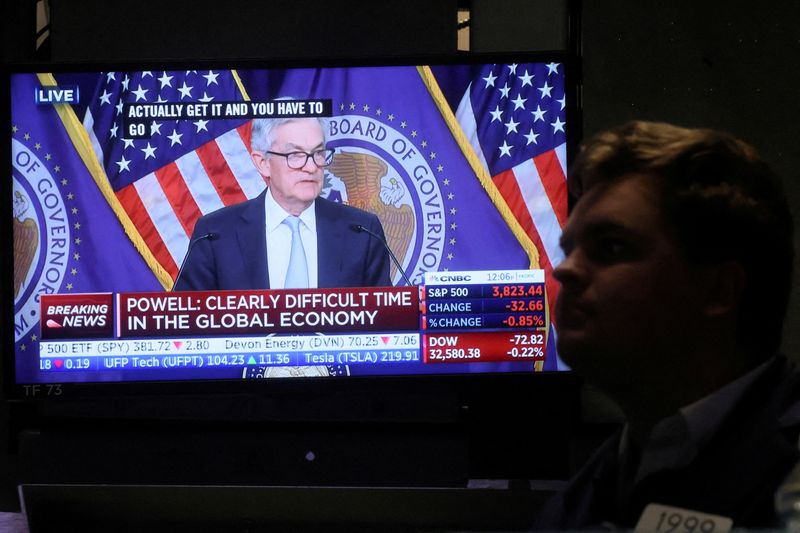Investor is warned so he is armed-Analysis
2022.12.12 07:16
[ad_1]

Investor is warned so he is armed-Analysis
Budrigannews.com – Investors are wary of the possibility that prolonged tightening could cause more harm to the economy than is necessary because central banks are beginning to slow aggressive rate rises but are far from finished, even as a recession looms.
This cycle, developed economies have been forced to raise borrowing costs by a total of 25.15 percentage points—the most aggressive increase in decades—as a result of rising inflation.
As a result, it’s not surprising that relief has been expressed by indications that the United States, the Eurozone, and Britain’s central banks will follow their smaller peers and slow the pace. From their lows in October, U.S. stocks are up 13%; In November, 10-year Treasury yields fell by 38 basis points, or 0.38 percentage points, the most since March 2020.
Markets nonetheless anticipate that the Federal Reserve will raise interest rates by more than 100 basis points (bps) to 5% in the second quarter of the following year. By the middle of 2023, the European Central Bank is anticipated to nearly double its deposit rate to just under 3%, up from 200 basis points in July.
Investors should be on the lookout for the possibility that excessive monetary tightening could speed up a downturn in the coming year, given the looming recession and potential inflation peak.
Robert Waldner, head of macro research at $1.3 trillion asset manager Invesco, stated, “We’re past the point of the big (Fed) policy mistake, we think they kind of made it.”
“They were too belligerent. They carried out numerous rate increases in a short amount of time.”
Recent research by the Fed suggests that the bank should aim for 3.52 percent rather than the current target of 3.75 percent-4 percent because it has exceeded the level required by commonly followed policy rules.
Waldner stated that he would recommend a pace of tightening that is even slower than the markets anticipate. He believes that rates are already too high, that inflation has reached its peak, and that growth is slowing down.
2022 gains have been erased by a 45 percent drop in oil prices since February. European costs are as yet raised, however down some 60% from a September top.
Producer prices are easing or decreasing, and supply chain disruptions are becoming less frequent. AS: ABN AMRO For the first time since late 2020,’s index of global bottlenecks returned to a neutral level in November.
The most recent inflation readings for the United States and the Euro Area were lower than anticipated.
Yes, overall economic growth figures have performed better than anticipated.
More Asos shares fall due to poor report
In any case, England’s economy shrank in the quarter to September, putting it near the very edge of a possibly extended downturn, U.S. fabricating is contracting and business action information focuses to a gentle euro region downturn. A Reuters poll predicts a recession in the United States within the next year at 60%, up from 25% in June.
Graphic: Thomas Costerg, senior U.S. economist at Pictet Wealth Management, is concerned about the disparity between forward-looking economic slowdown indicators and the strength of labor markets that the Fed wants to weaken.
U.S. contract rates have multiplied for this present year, applications are down some 40%. Apollo, an alternative asset manager, claims that home sales are declining much more quickly than they have in previous tightening cycles.
Financial conditions in September already reflected the equivalent of a 5.25% policy rate, according to Fed research that took into account mortgage premiums and corporate borrowing costs.
“The Fed is still focused on data from the past. Costerg expressed concern that the Fed might not be taking into account the lags in their monetary policy.
More Negotiations on Italian labor contracts postponed to January-Union
Additionally, research conducted by the OECD has demonstrated that when all advanced economies raise rates simultaneously, they have a greater impact on growth but less on lowering inflation.
Claudia Sahm, a former Fed economist, stated, “The Fed is seriously underestimating what happens to the U.S. economy if the global economy goes into a recession.”
Inflation has been largely driven by rising energy costs and limited supply in the euro area. Some believe that the ECB is pushing too hard because its rate hikes do little to ease those pressures.
While hawkish policymakers emphasize the necessity of preventing a wage-price spiral, they acknowledge that wage settlements of around 4% this year against 10% inflation do not appear to indicate one.
Graphic: Is the ECB going to slow down? Additionally, the ECB has stated that the anticipated recession will probably not be sufficient to control inflation.
According to Peter Praet, a former chief economist at the ECB, this kind of thinking could lead to a harder landing if the ECB didn’t say how big of a recession it thinks is needed to control inflation.
“What they’ve done as such far is fundamentally OK, yet the gamble of a mix-up has not vanished,” he said.
Markets are concerned that monetary policy will exacerbate economic pain, as evidenced by the fact that short-dated bonds from Germany and the United States are yielding significantly more than long-dated bonds. The United States’ two-year bond yield has recently reached its highest level since the early 1980s in comparison to the 10-year bond.
Erik Nielsen, chief economic adviser for UniCredit, advised the ECB to pause.
He wrote in a note, “My real concern is 2023-24, when this year’s monetary policy tightening will have maximum impact on demand and work as an amplifier of the pain on households and businesses of higher energy prices… just as most of the fiscal support may then need to be rolled back.” This year’s tightening is expected to have the greatest impact on demand and increase the pain. Graphic: Inverted US yield curve to an extreme








